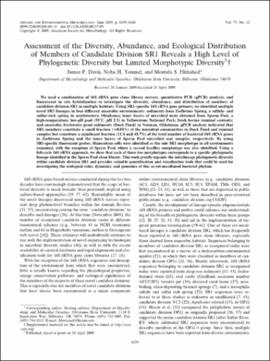| dc.contributor.author | Davis, James P. | |
| dc.contributor.author | Youssef, Noha H. | |
| dc.contributor.author | Elshahed, Mostafa S. | |
| dc.date.accessioned | 2018-08-29T14:24:29Z | |
| dc.date.available | 2018-08-29T14:24:29Z | |
| dc.date.issued | 2009-06 | |
| dc.identifier | oksd_davis_assessmentofth_2009 | |
| dc.identifier.citation | Davis, J. P., Youssef, N. H., & Elshahed, M. S. (2009). Assessment of the diversity, abundance, and ecological distribution of members of candidate division SR1 reveals a high level of phylogenetic diversity but limited morphotypic diversity. Applied and Environmental Microbiology, 75(12), 4139-4148. https://doi.org/10.1128/AEM.00137-09 | |
| dc.identifier.uri | https://hdl.handle.net/11244/301601 | |
| dc.description.abstract | We used a combination of 16S rRNA gene clone library surveys, quantitative PCR (qPCR) analysis, and fluorescent in situ hybridization to investigate the diversity, abundance, and distribution of members of candidate division SR1 in multiple habitats. Using SR1-specific 16S rRNA gene primers, we identified multiple novel SR1 lineages in four different anaerobic environments: sediments from Zodletone Spring, a sulfide- and sulfur-rich spring in southwestern Oklahoma; inner layers of microbial mats obtained from Sperm Pool, a high-temperature, low-pH pool (55°C, pH 2.5) in Yellowstone National Park; fresh bovine ruminal contents; and anaerobic freshwater pond sediments (Duck Pond) in Norman, Oklahoma. qPCR analysis indicated that SR1 members constitute a small fraction (<0.01%) of the microbial communities in Duck Pond and ruminal samples but constitute a significant fraction (11.6 and 48.7%) of the total number of bacterial 16S rRNA genes in Zodletone Spring and the inner layers of Sperm Pool microbial mat samples, respectively. By using SR1-specific fluorescent probes, filamentous cells were identified as the sole SR1 morphotype in all environments examined, with the exception of Sperm Pool, where a second bacillus morphotype was also identified. Using a full-cycle 16S rRNA approach, we show that each of these two morphotypes corresponds to a specific phylogenetic lineage identified in the Sperm Pool clone library. This work greatly expands the intralineage phylogenetic diversity within candidate division SR1 and provides valuable quantification and visualization tools that could be used for investigating the ecological roles, dynamics, and genomics of this as-yet-uncultured bacterial phylum. | |
| dc.format | application/pdf | |
| dc.language | en_US | |
| dc.publisher | American Society for Microbiology | |
| dc.rights | This material has been previously published. In the Oklahoma State University Library's institutional repository this version is made available through the open access principles and the terms of agreement/consent between the author(s) and the publisher. The permission policy on the use, reproduction or distribution of the material falls under fair use for educational, scholarship, and research purposes. Contact Digital Resources and Discovery Services at lib-dls@okstate.edu or 405-744-9161 for further information. | |
| dc.title | Assessment of the diversity, abundance, and ecological distribution of members of candidate division SR1 reveals a high level of phylogenetic diversity but limited morphotypic diversity | |
| osu.filename | oksd_davis_assessmentofth_2009.pdf | |
| dc.description.peerreview | Peer reviewed | |
| dc.identifier.doi | 10.1128/AEM.00137-09 | |
| dc.description.department | Microbiology and Molecular Genetics | |
| dc.type.genre | Article | |
| dc.type.material | Text | |
| dc.subject.keywords | bacteria | |
| dc.subject.keywords | biodiversity | |
| dc.subject.keywords | cattle | |
| dc.subject.keywords | ecosystem | |
| dc.subject.keywords | geologic sediments | |
| dc.subject.keywords | phylogeny | |
